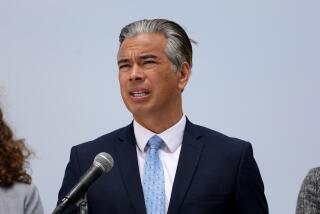State Aides Knew Exxon Valdez Still Had Oil Residues
- Share via
SACRAMENTO — State Fish and Game Department officials knew last month that tanks in the Exxon Valdez contained oil residues but expected most of the substance to be cleansed from the tanker in international waters before it entered San Diego Bay, according to a letter from the agency.
The letter, dated June 30 and addressed to Assemblyman Steve Peace (D-La Mesa), noted that while oil concentrations in the ship’s tanks were below federal levels for discharges in the ocean, they exceeded those permitted by the state.
But state officials said Thursday that while they expected “traces” of oily discharge from the tanker as it arrived offshore of San Diego, they were surprised by the 18-mile slick and several other discharges believed to have come from the Valdez.
A San Diego environmentalist said Thursday that the letter was proof that Exxon and federal government officials “lied” about the absence of petroleum in the tanker before it began its journey to San Diego for repairs.
“I think it is a clear acknowledgement that there was oil and oil residue in the vessel,” said Diane Takvorian, executive director of the nonprofit Environmental Health Coalition.
“The assurances that we received from the Coast Guard and the Exxon officials were that this (ship) was squeaky clean,” she said.
Mike Herlache, a patrol captain with the Department of Fish and Game’s oil pollution unit, responded that the agency relied on reports from the Coast Guard and Exxon in satisfying itself that the Valdez was “very clean” before leaving Alaskan waters.
Herlache said the reports showed that there was oil residue left in the ship.
“I think that you’re being real naive to think that there’s not going to be any oil residues in a tanker,” he said.
State officials remain uncertain whether the substance that has leaked from the Valdez since Monday contains oil. The Coast Guard and Fish and Game “understood there was going to be traces,” said Curt Taucher, a spokesman for the department, “but not anywhere near what it has been.”
The Fish and Game department determined that the concentration of oil did not exceed the federal limit, which is generally regarded as any amount that will not leave a sheen in the water. The federal level for acceptable oil discharge into the ocean is 12 parts of oil per million parts of water, while the state level is a more stringent 1.5 ppm, officials said.
“The petroleum hydrocarbon levels are above what we consider permissible for a continuing discharge,” Fish and Game Director Pete Bontadelli said in the letter.
“It is anticipated that the interchange of seawater in international waters during the vessel’s journey to San Diego will lower the petroleum hydrocarbon levels,” Bontadelli wrote.
Meanwhile, Coast Guard tests released Thursday showed no evidence of oil in an offshore slick probably caused by the Exxon Valdez, contradicting earlier state tests that confirmed that the tanker’s discharges were petroleum-based.
Exxon Shipping Co. officials welcomed the announcement. But Coast Guard officials downplayed the results, and state authorities are adamant that the substance leaked in the 18-mile slick discovered 30 miles offshore Monday was oil.
In a related development, Alaska officials said the Valdez trailed a one-mile sheen of oil as it left Prince William Sound on June 23. The source is suspected to be a waxy crust that had built up on the inside of the ballast tanks, Herlache said.
Ralph Frammolino reported from Sacramento and Lori Grange from San Diego.
More to Read
Sign up for Essential California
The most important California stories and recommendations in your inbox every morning.
You may occasionally receive promotional content from the Los Angeles Times.













